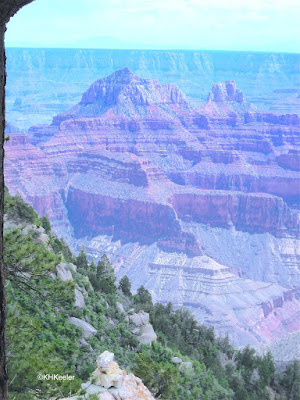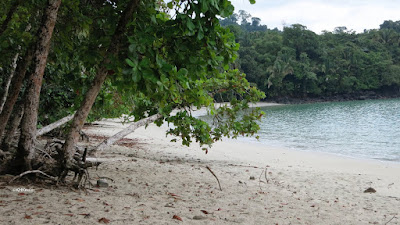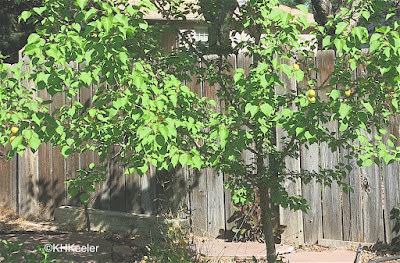There are great pressures on scenic areas. The internet provides "best" lists, resulting in vast crowds coming to "must see" places. And yet I recommend seeing the Grand Canyon, one of those "must sees." It is a wonder of the world.
Monday, December 31, 2018
Sunday, December 23, 2018
Plant Names and Families
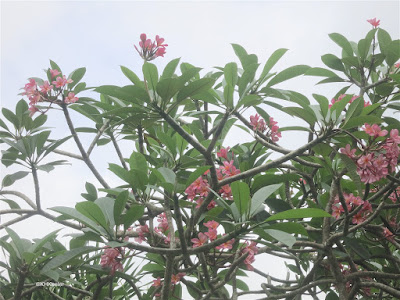 |
| Indian temple tree (Plumeria, dogbane family, Apocynaceae) |
I recently settled down to read a technical book on ecology and found the references (Somebody 2002, Somebodyelse and Coauthor 2011) distracting. Annoying, actually. There was a time when I read over those without a thought.
I elected from the beginning to include references in this blog, but only at the end. But I do stick in technical plant name information (Fancylatin name, twig family, Fancylatinaceae), every time I mention a plant. I am not about to give that up, intrusive as it is. So perhaps I should explain again.
Sunday, December 16, 2018
Homogenized World--Attractive and Useful Tropical Plants
The same applies to smaller plants
Pineapples (Ananas comosus, bromeliad family, Bromeliaceae), popularly associated with Hawaii, are from Central America and the Caribbean.
Sunday, December 9, 2018
Plant Story - Garlic, Allium sativum, the Great Protector
Sunday, December 2, 2018
Parks and Wilderness, Access and Overuse
 |
| View from Alpine Visitor Center Rocky Mountain National Park |
 |
| Grand Canyon, from the North Rim |
Sunday, November 25, 2018
Plants on Walls
Tuesday, November 20, 2018
Homogenized World--Tropical Plant Distributions
I am writing a novel about Paraguay in 1630--because when I saw northern Argentina and Paraguay in the 1980s I was surprised by their natural history and history and have wanted to share their stories.
In trying to bring the 17th century to life, I have to describe what was there and that has been quite an adventure because there has been so much change.
Beginning in the 1500s, conquering and colonizing, European powers carried useful plants all over the world. To describe our world early in that process, I have to figure out what plants are native to the Americas and which were introduced. If it is native to the Americas, it will likely be new to Europeans. If it is from Africa or China, it may not yet be common in South America even if it is abundant there today.
Sunday, November 11, 2018
Winter Escape--Honolulu
As the days get colder, I daydream about tropical beaches.
For example, in Hawaii
While I always recommend the Big Island if you are going to Hawaii (for its diversity and its active volcano) I recently did a successful experiment--I had a great botanical time from a single hotel in a easily-reached city. We simply flew to Honolulu last May, stayed in a hotel there, and explored from there.
For example, in Hawaii
While I always recommend the Big Island if you are going to Hawaii (for its diversity and its active volcano) I recently did a successful experiment--I had a great botanical time from a single hotel in a easily-reached city. We simply flew to Honolulu last May, stayed in a hotel there, and explored from there.
 |
| View from hotel window |
Sunday, November 4, 2018
Winter Escape--Costa Rica
Sunday, October 28, 2018
Plant Story--Papaya, Tropical American Fruit
Sunday, October 21, 2018
Plant Story--More on Prickly Pear Cacti, Flowers and Fruits
Prickly pear cacti, genus Opuntia, are easily-recognized members of the cactus family (Cactaceae) with a very wide native range across the Americas. There are more than 150 species, native from southern Canada to Argentina and Chile. They are also called nopales (singular nopal).
Sunday, October 14, 2018
Plant Story--Prickly Pear Cacti, Wonderfully Spiny
Cacti do not get a lot of appreciation. As a very visible, common cactus, that certainly applies to the prickly pears, Opuntia species. These plants are easily recognised, avoided and disliked.
Sunday, October 7, 2018
Visiting Colorado--Fall Mountain Scenes
It is fall in the Rockies. The aspen leaves are turning colors. As I write this in early October, Trail Ridge Road at the top of Rocky Mountain National Park is closed due to snow. It should reopen, but, clearly, it is winter now at 11,000 feet. Where I live, at 5,000 feet, we have not yet had a frost. As cold temperatures move down the mountains, aspen and other deciduous trees will change color and then lose their leaves at successively lower elevations. Lots of opportunity to enjoy the spectacle.
Sunday, September 30, 2018
Visiting Colorado--Loving Maroon Bells
The place is beautiful. It is also being loved to death.
Sunday, September 23, 2018
Plant Story--Castor, Tall, Beautiful and Deadly
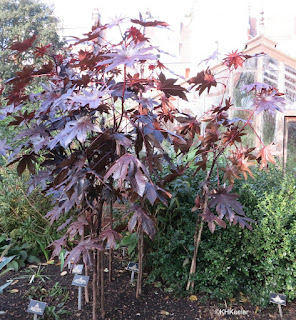 |
| castor, Ricinis communis |
In those days, I was told the plant that castor oil came from was called the castor bean. Although you still see it, the name castor bean is "out" today, because usually beans are plants in the pea family, legumes (Fabaceae) and castor, Ricinus communis, is a spurge, related to croton and poinsettia (Euphorbiaceae). You will see castor oil plant or just castor as we struggle to say it better.
You can see why the name: the seeds do look like beans.
 |
| Seeds of castor, Ricinis communis |
Sunday, September 16, 2018
Gardens of Near Philadelphia, Pennsylvania
Sunday, September 9, 2018
Plant Story--Beautiful, Invasive Lantana, Lantana camara
Lantana, Lantana camara (in the verbena family, Verbenaceae) is a common ornamental and an easy plant to recognize. It is a tropical American shrub, native to Central and South America. In wild plants, the open flowers in the center of the group are yellow while the older flowers around them are orange. But there were enough natural color variants and related species with flowers of other colors that to grow in your garden you can find lantana with flowers ranging from white and lavender to pink, yellow orange and deep red. (link)
Sunday, September 2, 2018
Edible Plants--Conflicting Stories
 |
| elderberry, Sambucus, with unripe berries |
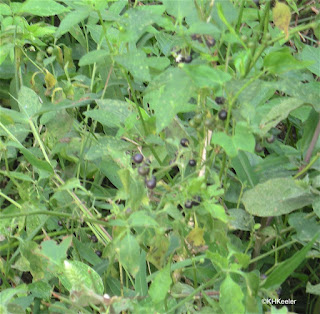 |
| a nightshade, Solanum species |
Sunday, August 26, 2018
What Happened to Rosemary?
Rosemary is a sun-loving plant of the rocky areas along the Mediterranean Sea, from the south of Spain into the Middle East. Her leaves are long and fragrant, her flowers a beautiful purple. Long ago humans found her scent calming and the oils in her leaves a fine flavoring. She had two close relatives, sisters you might say, but they grew only in local areas near her, while rosemary herself was carried around the world by humans. (See previous blog about rosemary link).
But one day, in 2015, botanists sent rosemary's DNA off to the botanical equivalent AncestryDNA and when the results came back, they were shocking.
Sunday, August 19, 2018
Visiting Minnesota--Lovely Forestville State Park
I took a field trip to Forestville/ Mystery Cave State Park during the Botanical Society of America meetings (meeting post). It is a reserve in the driftless region, places the glaciers somehow missed. The glaciers nevertheless rearranged the area, as rivers of meltwater cut deep channels and, slowing, dropped everything from sand to boulders.
Today the area is at the western edge of the great Eastern Deciduous Forest that covered the eastern United States. The forest in Forestville is secondary growth, having been farmland in the 1890s, but progressively abandoned thereafter, officially designated a state park in the 1960s. Minnesota Parks has making a concerted effort to remove weeds and favor native plants. Experts can show you the imperfections, but to a casual visitor, it is a lovely forest.
Sunday, August 12, 2018
Visiting Colorado--Old Fall River Road, Rocky Mountain National Park
 |
| Almost to the top of Old Fall River Road |
Long vehicles are discouraged. We were a bit concerned about taking a Prius but in fact having a compact car made the turns, some truly hair-pin, easier for us than for bigger vehicles. Had it been after a heavy rain, we might have regretted the Prius: there were muddy ruts in the road, some quite deep, but when we were there, dry and easily avoided.
So on a sunny morning we headed up Old Fall River Road.
Sunday, August 5, 2018
Botanists at Work--Botany2018 Meeting
This year I again attended the Botanical Society of America annual meeting this year in Rochester, Minnesota. I go to keep up--since I write this blog from retirement, attending professional meetings helps me check that I am providing accurate information.
So I attended general lectures and technical papers, read posters, looked at the books the publishers brought and, of course, talked to people.
So I attended general lectures and technical papers, read posters, looked at the books the publishers brought and, of course, talked to people.
Sunday, July 29, 2018
Plant Story--Apricot Folklore
Apricots (Prunus armeniaca, see previous post link) have been in cultivation more than 5,000 years, so of course there are all kinds of folk tales.
The plant was probably domesticated in China--it is mentioned in texts from about 500 BCE. Apricots in flower became the floral symbol of the second month of the Chinese calendar. The second month generally corresponds more to March than February since the Chinese lunar calendar begins with the first new moon after the half-way point between the winter solstice and spring equinox. In China under the emperors, civil service jobs, highly desirable jobs, were chosen by testing the candidates in very difficult examinations. Those were administered at the beginning of the year, so apricot flowers in the second month were also "successful candidate flowers" as examinations were completed and winners announced. I don't have a photo that I am sure is Prunus armeniaca in flower, so here it is online link. Other apricots, for example the Japanese apricot, Prunus mume, flower later in the spring.
Sunday, July 22, 2018
Visiting Switzerland--Enjoying Mountain Wildflowers
This was a visit into the mountains of Switzerland simply to enjoy being there, which meant mountain scenes, cheese and chocolate, and especially, the flowers.
The flora of Northern Europe has many similarities to that of eastern North America and high elevation plants in the Alps have close relatives in the Rocky Mountains, so I knew many of the plants. Sort of. Because, apart from widespread weeds, North America's plants are only related to Europe's, not identical.
Where I actually knew the plants, they were European natives that are now weeds in North America.
Of course the dandelion, Taraxacum officinale (sunflower family, Asteraceae) - a source of food and medicine across the Europe in the 17th century, so it brought to North America intentionally, then we stopped using it and it got away.
The flora of Northern Europe has many similarities to that of eastern North America and high elevation plants in the Alps have close relatives in the Rocky Mountains, so I knew many of the plants. Sort of. Because, apart from widespread weeds, North America's plants are only related to Europe's, not identical.
Where I actually knew the plants, they were European natives that are now weeds in North America.
Of course the dandelion, Taraxacum officinale (sunflower family, Asteraceae) - a source of food and medicine across the Europe in the 17th century, so it brought to North America intentionally, then we stopped using it and it got away.
 |
| dandelions in Switzerland |
Sunday, July 15, 2018
Plant Story--Adaptable Apricots
Sunday, July 8, 2018
Plant Story--Needle-and-Thread Grass, Graceful and Sharp
Needle-and-thread grass (Hesperostipa comata, formerly is Stipa comata, grass family Poaceae) is native to the northwestern three quarters of North America, found especially on dry or sandy sites. It is a beautiful grass, with long slightly nodding heads that catch the sunlight and nod in the wind.
Sunday, July 1, 2018
Wishing You a Happy July
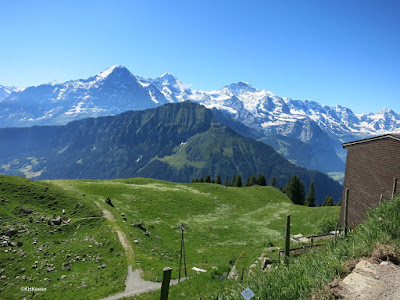 |
| Swiss Alps |
Almost always, creating a post for this blog is great fun. But I'm jet-lagged having just returned from Switzerland. Since Switzerland is 7 hours ahead of Colorado, I am alert in the middle of the night and sleepy at dinnertime. Writing well-thought-out sentences eludes me.
What to do? Share photographs. It is a big beautiful world. Message: get out, observe, enjoy.
Sunday, June 24, 2018
Plant Story--Native Wildflower, Gumweed, Grindelia
Gumweeds, genus Grindelia (sunflower family, Asteraceae) are roadside wildflowers, most common in western North America but with a few species in the East and South. A gumweed is easy to recognize: note the funny spines around the flower buds (especially visible in the picture below). In addition, gumweeds are gummy--if you touch the buds or flowers, sticky stuff comes off on your fingers.
But there is a lot more to gumweeds.
Sunday, June 17, 2018
Visiting Hawaii--Cactus Garden in Honolulu
A farmer's market gathers each Saturday in Honolulu, just below Kapi'olani Community College. It was fun shopping there: macadamia nuts, kona coffee, guavas, pineapples and chocolates. But I was distracted and spent most of my time in the garden behind the farmer's market, Kapi'olani Community College's Cactus Garden.
Sunday, June 10, 2018
Plant Story--Evening Primroses, Beautiful Whereever You Meet Them
There are 145 species of evening primrose, Oenothera, 80 of them native to the United States.While there are more different species in western North America, the common evening primrose, Oenothera biennis, can be found in all but the Rocky Mountain states.
Evening primroses have big flowers. If you find them open after 7 am or before 7 pm, the flowers are likely yellow. Night-flowering species are often white and close in daylight, so if you are to see them open you need to go out in twilight, wander with a flashlight or get up early. On a cloudy morning they stay open longer, but the white species tend to grow in drier places, where cloudy mornings are less common.
Evening primroses have big flowers. If you find them open after 7 am or before 7 pm, the flowers are likely yellow. Night-flowering species are often white and close in daylight, so if you are to see them open you need to go out in twilight, wander with a flashlight or get up early. On a cloudy morning they stay open longer, but the white species tend to grow in drier places, where cloudy mornings are less common.
 |
| An evening primrose seen in southern Wyoming. |
Sunday, June 3, 2018
Visiting Australia--Remote, Central, Alice Springs
Sunday, May 27, 2018
Plant Story--Evening Primroses, Names and Relations
Evening primroses were one of the first midwestern wildflowers I learned. Partly because they are so spectacular
I quickly figured out they were not roses or primroses (more on that below). The evening primroses are some 145 species native to the Americas, in the genus Oenothera, in the evening primrose family, Onagraceae. The U.S.D.A. lists 80 species of Oenothera native to North America. With beautiful flowers!
 |
| Missouri eveing primrose Oenothera missouriensis in the grassland |
Sunday, May 20, 2018
Visiting Oahu--Wahiawa Botanical Garden, Tropical at 1000'
In the center of the island of Oahu is the Wahiawa Botanical Garden. Part of the Honolulu Botanical Gardens system, it is at about 1000' above sea level and contains tropical plants that like a lot of rain at cooler temperatures. Conveniently located half way between Honolulu and the beaches of Oahu's North Shore, it features heliconias, figs, and economically important tropical plants such as coffee, chicle (source of chewing gum) and cinnamon, as well as spectacular ornamentals.
Sunday, May 13, 2018
Plant Story--Daylilies, From Asia, Beautiful and Not Lilies
Everyone always has grown daylilies and their story is well-known. It seemed. When I looked carefully, I totally rewrote this blog post.
Daylilies have been in U.S. gardens since the 1600s. It is commonly reported that both Dioscorides and Pliny in ancient Rome (1st century AD) wrote about them, but careful analysis has shown they were describing a lily, not a daylily. Daylilies came to the West from China, after 1500.
Daylilies have been in U.S. gardens since the 1600s. It is commonly reported that both Dioscorides and Pliny in ancient Rome (1st century AD) wrote about them, but careful analysis has shown they were describing a lily, not a daylily. Daylilies came to the West from China, after 1500.
Sunday, May 6, 2018
Visiting Hawaii--HIstoric Foster Botanical Garden
I recently took an off-season holiday in Honolulu, Hawaii. Inevitably, my steps took me to botanic gardens. One of Honolulu’s highlights is Foster Botanical Garden. In the heart of modern Honolulu, it was once part of the estate of the Hawaiian Queen Kalama (1817-1870), was planted with tropical trees that might become cash crops on the Islands by Dr. William Hildebrand (1821-1886) in the middle 1800s and ultimately donated to the City and County of Honolulu in 1930 by Mary Robinson Foster (1844-1930), of royal Hawaiian descent and widow of sea captain Thomas Foster (1835-1889).
Many of the trees are huge, for example:
Many of the trees are huge, for example:
Queensland kauri, Aganthis robusta, an Australian tree in the Auricariaceae, a family of Southern Hemisphere conifers. They can grow 150 feet tall and 24 feet wide and produce lots of desirable wood.
Sunday, April 29, 2018
Visiting Northern Colorado--Early Spring Wildflowers
 |
| Plants seen along the Devil's Backbone Trail, Loveland, Colorado |
Well, that is one way to say it. Another is that the cool temperatures extended the visibility of the early flowers.
Labels:
a wandering botanist,
Agroseris,
botany,
Colorado,
early spring,
false dandelions,
Leucocrinum,
locoweed,
Lomatium,
Musineon,
Nothocalais,
Oxytropis sericea,
sand lily,
wild parsley,
wildflowers
Sunday, April 22, 2018
Cosmopolitan Weeds--Friends of the Botanical Traveler
 |
| Victoria, Australia |
 |
| dandelion, Taraxacum officiale |
Subscribe to:
Comments (Atom)
